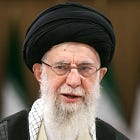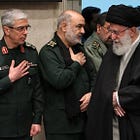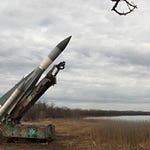History did not begin on Inauguration Day. Iran has developed a non-civilian uranium enrichment program for decades while Benjamin Netanyahu kept telling the Americans to do something about it. From its first test in 2007, the GBU-57 Massive Ordnance Penetrator (MOP) was designed to fly in a B-2 Spirit and crack open very deep bunkers exactly like Fordow. When the Air Force added the MOP to their congressional funding request in 2011, ABC News asked: “Is the US Preparing to Bomb Iran?” Everyone already knew the answer was yes. Obviously yes. Operation Midnight Hammer should not have surprised anyone.
Ali Akbar Salehi, former chief of the Atomic Energy Organization of Iran and present-day Foreign Minister, told an Iranian state TV program in February 2024 that "we have all the [pieces] of nuclear science and technology” to build a nuclear bomb. He compared a nuclear weapon to a car, which consists of “a chassis, it needs an engine, it needs a steering wheel, it needs a gearbox. Have you made a gearbox? I say yes. An engine? But each one is for its own purpose.” A nuclear breakout seemed imminent, especially as Israel systematically deconstructed Iran’s proxies after 7 October.
For by this April, a generational handover of power also seemed imminent. Ayatollah Ali Khamenei was turning 86 years old and rumored to be in poor health. He has groomed his son Mojtaba to take his place as supreme jurist of the Islamic Republic, and a nuclear breakout option was likely supposed to secure the future of the regime at the handover. All of this happened before Donald Trump’s 60-day window of opportunity for a ‘nuclear deal’ expired. This once, we were all supposed to take him literally and not just seriously.
The strike took place six days after Trump announced on his Truth Social platform that “Everyone should evacuate Teheran immediately!!” Pressed for clarity by a reporter on Air Force One shortly thereafter, Trump said he had not implied any threat to the Iranian capitol. “No not at all,” he replied. “I want people to be safe. And that's always possible. A thing like that could happen.” Clear as mud.
Civilians meanwhile already jammed the highways out of Tehran as residents fled potential disorder — and regime apparatchiks fled a potential coup. Uncertainty and paranoia add to the strategic paralysis of a regime in crisis.
In another social media post on Tuesday, Trump indicated that he was holding Israelis back from killing the supreme leader, whose location was known. “He is an easy target, but is safe there,” Trump wrote. “We are not going to take him out (kill!), at least not for now. But we don't want missiles shot at civilians, or American soldiers. Our patience is wearing thin.” The we/our pronouns seemed ominous. Trump wanted “UNCONDITIONAL SURRENDER.” The world wondered: was the president preparing to bomb the Fordow facility?
Because again, as everyone had known for more than decade, the United States Air Force developed the GBU-57 MOP to do exactly this one neat trick.
The Israelis did not have MOPs. Barring American action against Fordow, their only viable option would have been a complex and risky commando operation. Saturday’s scenario had therefore been foreseen, discussed, and wargamed by all three combatants, and a host of major powers, for a very long time. No surprises should have been possible, as news of the heavily-laden B-2s flying to the Middle East was all over the X app for a day beforehand.
Military historians will wonder how the regime seemingly missed so many obvious signs and opportunities, allowing the IAF and then the USAF to have complete command of their skies, control the initiative, and act with impunity. I propose the answer has two parts, one material and the other moral.
Operation Rising Lion has exposed the hollow state of Iran’s military to the world. Distrustful, the mullahs have neglected their regular conventional forces for years, relying instead on the Islamic Revolutionary Guards Corps (IRGC), their parallel military organization, for security at home and adventures abroad. Rocket forces have received generous funding while the Artesh, the regular army, has languished. Iran has not kept up with the 5th generation fighter race — in fact, they have not built up their air force at all. These procurement choices took years to become Iran’s material means of fighting the current war. The clerics did not build their war machinery to sustain a war of attrition, but to sustain their regime. Importantly, the regime is premised on resistance to Israel, the United States, and the western order.
Currently, the IAF is engaged in attritional war with Iran’s rocket forces. Although the mullahs spent lavishly on underground missile bunkers, they only have so many transporter-erector-launcher (TEL) vehicles in their inventory. Israeli warplanes are in the air over Iran at all times, so every TEL that launches a ballistic missile at Israel risks immediate detection and then destruction in a matter of moments. Israelis have tracked TELs from deployment to setup, hitting them before launch, as in this video clip released by the IDF.
This TEL was blown up just seconds before launch. To achieve this kind of observation and real-time interdiction, the Israelis spent decades building up intelligence capabilities inside of Iran. Perhaps this video feed is even coming from a Mossad drone. The point is that Iran’s overreliance on TELs as their primary mode of attacking Israel was a potential liability that Israel developed means to exploit. They know what Iran would do and prepared to meet that challenge.
Iran on the other hand has been unable to overwhelm Israeli defenses, scoring only a handful of hits on Israeli cities. Tragic as civilian deaths are, these attacks are not doing material harm to the IDF’s warmaking capabilities. Meanwhile, the IAF is systematically reducing Iran’s ability to launch missiles at all. Put simply, Tehran is running out of ways to punish Tel Aviv.
Israel on the other hand has denied reports they are running low on interceptor missiles, in fact they have used fewer at this point than they had planned to use, in the event of war. “The IDF estimated that Iran would fire several hundred ballistic missiles at Israel in its initial response. In reality, it mustered just 100,” reports the Times of Israel. “In all, some 470 ballistic missiles have been fired from Iran at Israel in the past week, below the IDF’s ‘reference scenario’ for the operation.”
Material underperformance has a moral component: overconfidence, likely borne of religious chauvinism and an institutional culture of contempt for their Israeli enemies at the IRGC. Fanatics are rarely capable of self-reflection, hence unable to see themselves as others see them, so they give away too much, and too often fail to ‘red-team’ or test their own side.
Iran should not have been caught by surprise, nor should decapitation strikes have succeeded so brilliantly against the IRGC. Israel should not have air supremacy over Iran, right now. The war ought not to be this one-sided, but it is, because of decisions made many years ago, and professional incompetence endemic to totalitarian regimes.
Khamenei has limited options to retaliate against the United States now, at least right away. He could try hitting US bases in the Middle East, for example, but this would expose his hollow military to further devastation. In 1988, after a destroyer was damaged by an Iranian mine, the US Navy inflicted a crushing one-day defeat on the Iranian Navy, wrecking two weaponized oil platforms, sinking three warships, and shooting down two jets and a helicopter while pummeling the small boats that Iran used to menace traffic in the Strait of Hormuz. Today’s US Navy could go even harder, whereas Iran’s navy could not, really. Iran could try closing the Strait of Hormuz, but this would cut the mullahs off from their own oil export revenue. There are few ways for Tehran to impose costs on the Americans through force of arms, anymore.
Open confrontation is therefore unlikely. Assuming the Khameneis restore stability to their regime, their revenge will have to be served cold. Retail terrorism is the regime’s strength, anyway, whereas wholesale battle is their weakness. Israelis understand this better than Americans, who are by and large receiving these events as a sequel to the occupation of Iraq, which left lasting psychic scars on Americans.
The War of the Iranian Atom is already over, though. It was won many years ago by a US Air Force appropriations process. The scenario in which any American boots are needed on Iranian ground has just become very far-fetched, indeed its chances have been blown to smithereens by fourteen MOPs containing 8,400 lbs. of high explosive. No military draft will follow these events. World War III has been canceled. Iran is not Iraq. Zero new Middle Eastern quagmires are entrapping American military power. Everyone is already back home from the mission.
Many people are nevertheless angry about this development. Democrats complain that President Trump did not consult them, which the Constitution of the United States and the War Powers Act do not require him to do. The isolationist wing of MAGA is not happy, nor are the progressive left (“useful idiots”) who think Iran’s bourgeois revolution will smash capitalism for them. Palestine, that ultimate cause of the oppression hierarchy of the global left, stands to be lost forever if the clerics lose power in Tehran. Won’t someone think of the poor campus Trotskyites?
Losers and winners are being sorted in the aftermath. Tulsi Gabbard, who seemed to be on the outs with Trump over Iran, was inside the Situation Room. Rumors of her disagreement over the intelligence turn out to have been greatly exaggerated. Speaking to Congress, Gabbard had indicated that the Iranian nuclear program was officially inactive. But “we’ve seen an erosion of the decades-long taboo in Iran about discussing nuclear weapons in public,” she added, “likely emboldening nuclear advocates in Iran’s decision-making apparatus” — the same command and control structure that has been subject to Israeli decapitation strikes. When Gabbard spoke, “Iran’s enriched uranium stockpile [was] at its highest levels, and [was] unprecedented for a state without nuclear weapons.”
The biggest losers of all, of course, are the former Obama regime. Ben Rhodes, who held ridiculous daydreams of rapprochement with the clerical regime, is crushed. So is Rob Malley, Obama’s JCPOA negotiator, who lost his security clearance under Biden in a scandal that involved alleged agents of Iranian influence. Here is Richard Stengel, Obama's Under Secretary of State for Public Diplomacy and Public Affairs, explaining that chants of “Death to America” mean nothing at all, because the Iranian kids like blue jeans, or something. “We have a lot more in common with them than we do with a lot of countries that we do have alliances with.”
“Why is it a foundational issue for Trump that Iran doesn’t have a nuclear weapon?” Stengel asks. We might ask in return just why letting Iran develop nuclear weapons was such a foundational issue for Team Obama. “Why are we allied with Israel?” Stengel asks. Team Obama believed that the regime would honestly trade sacred nuclear ambitions against Israel for normalized relations with the Great Satan. They had their own moral failing: a belief in moral arcs that bend toward justice, when there are people in the world who define ‘justice’ as Death to America.
The irony, of course, is that MOPs were developed and purchased during the first Obama term. Materially, they did at least prepare their successors for the worst. For this much, we can thank them: they made the bombs that made OP Midnight Hammer possible.
How To Cultivate A Strategy
“The concept of strategic culture is not a difficult idea to grasp and explain,” the late Colin Gray writes in the Handbook of Strategic Culture. “Indeed, it is really so simple that it warrants ascription as being little more than common sense.” In his simplest phrasing, “every society, or security community, has a more or less distinctive strategic culture which is the product of its historical experience as that experience is perceived.” Our collective perceptions of history shape our strategy. “Moreover, every society makes war, and conducts warfare, according to its distinctive character, subject always to the discipline of circumstance.” Strategic culture must be flexible. “Because warfare is by definition a competitive pursuit, cultural eccentricity is apt to be disciplined by the enemy, actual or anticipated,” Gray writes. “Strategy is an inherently pragmatic activity.”











